Easy, Creamy 5-Ingredient Mac and Cheese
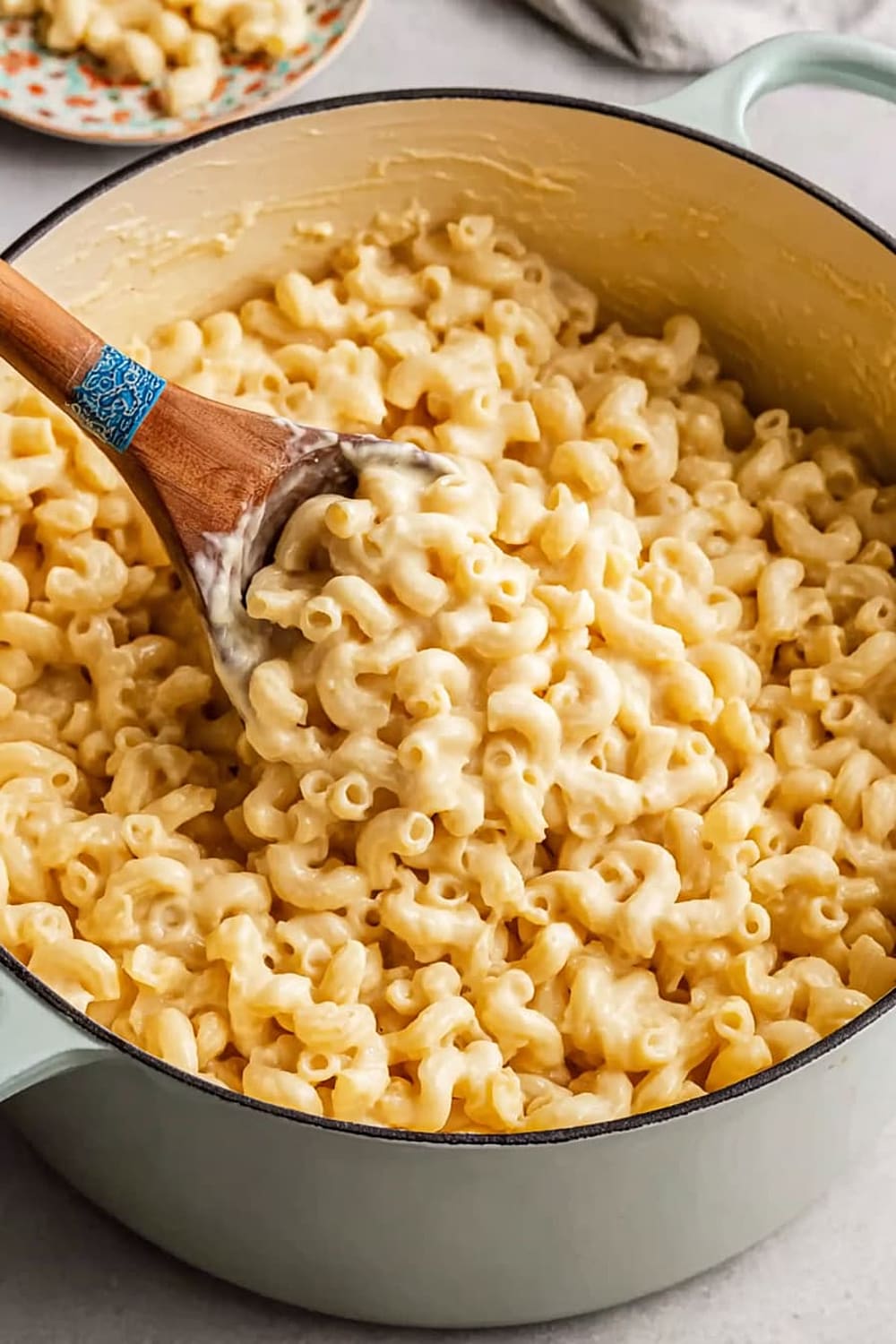
This mac and cheese is about to ruin every boxed version for you forever – and honestly, you deserve better than that orange powder anyway.
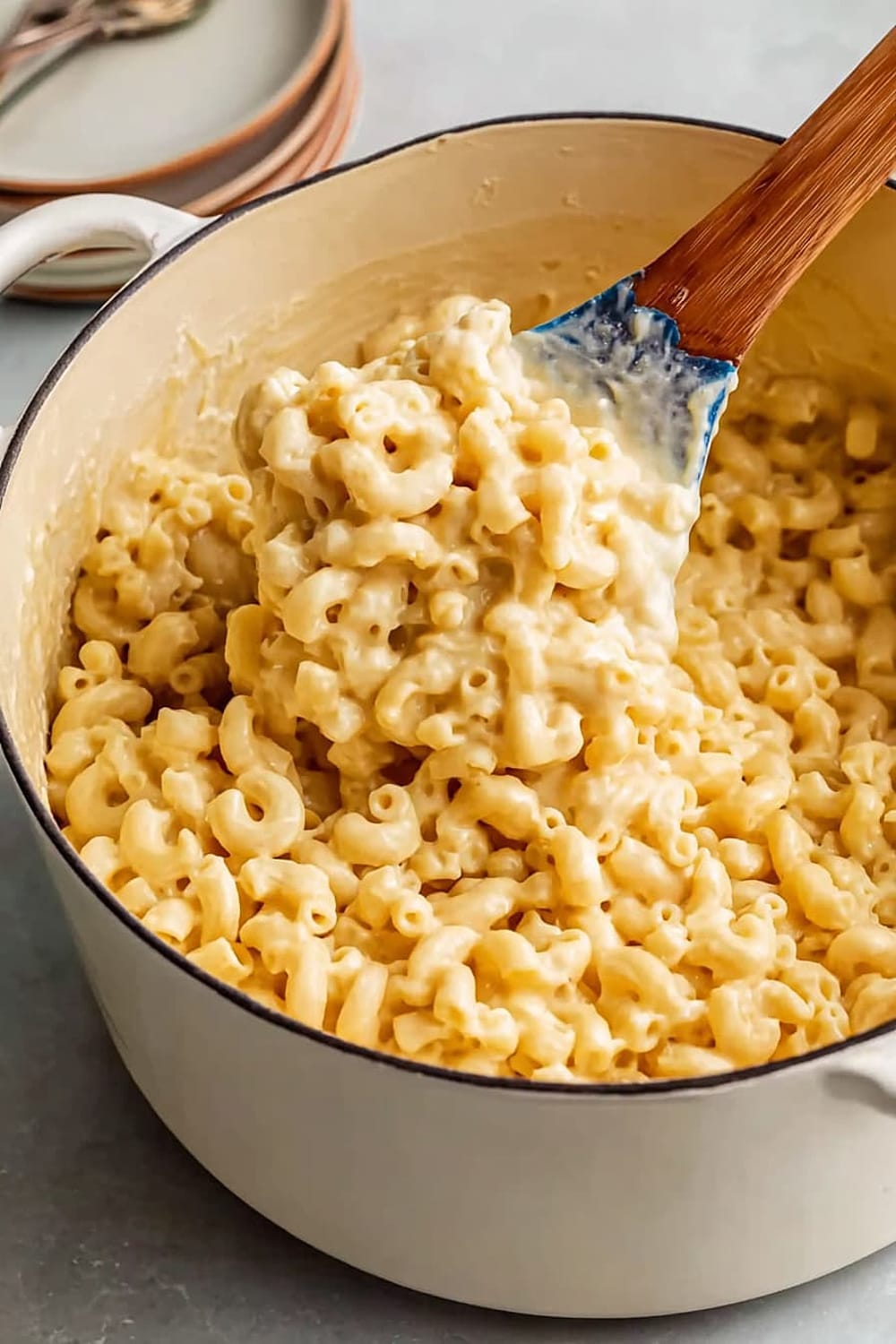
We’re talking about silky, restaurant-quality cheese sauce that happens in one pot with ingredients you probably already have sitting in your kitchen right now.
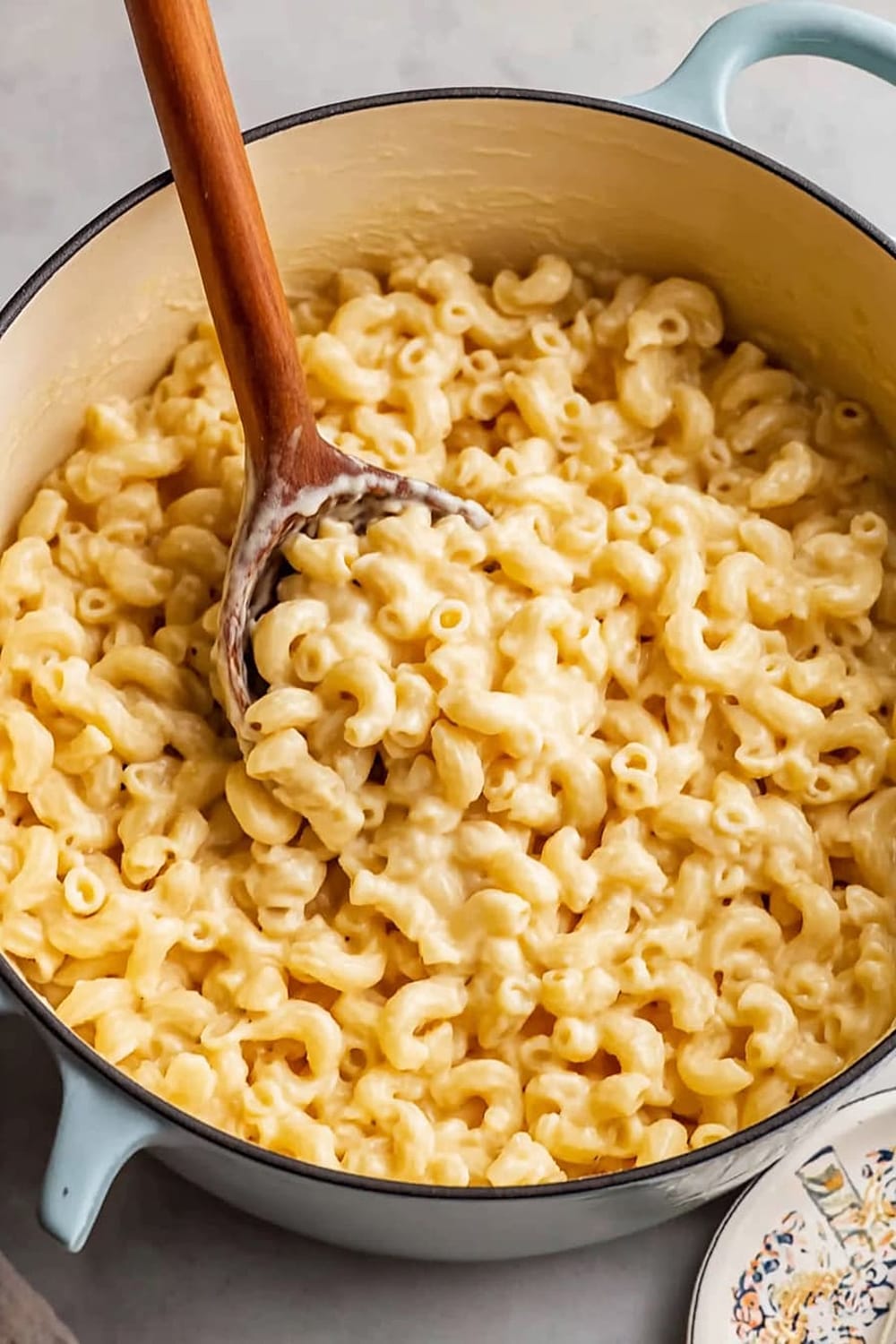
The secret isn’t some fancy technique or expensive ingredients – it’s cooking the pasta directly in milk and water, which creates its own starchy, creamy base that clings to every single noodle.
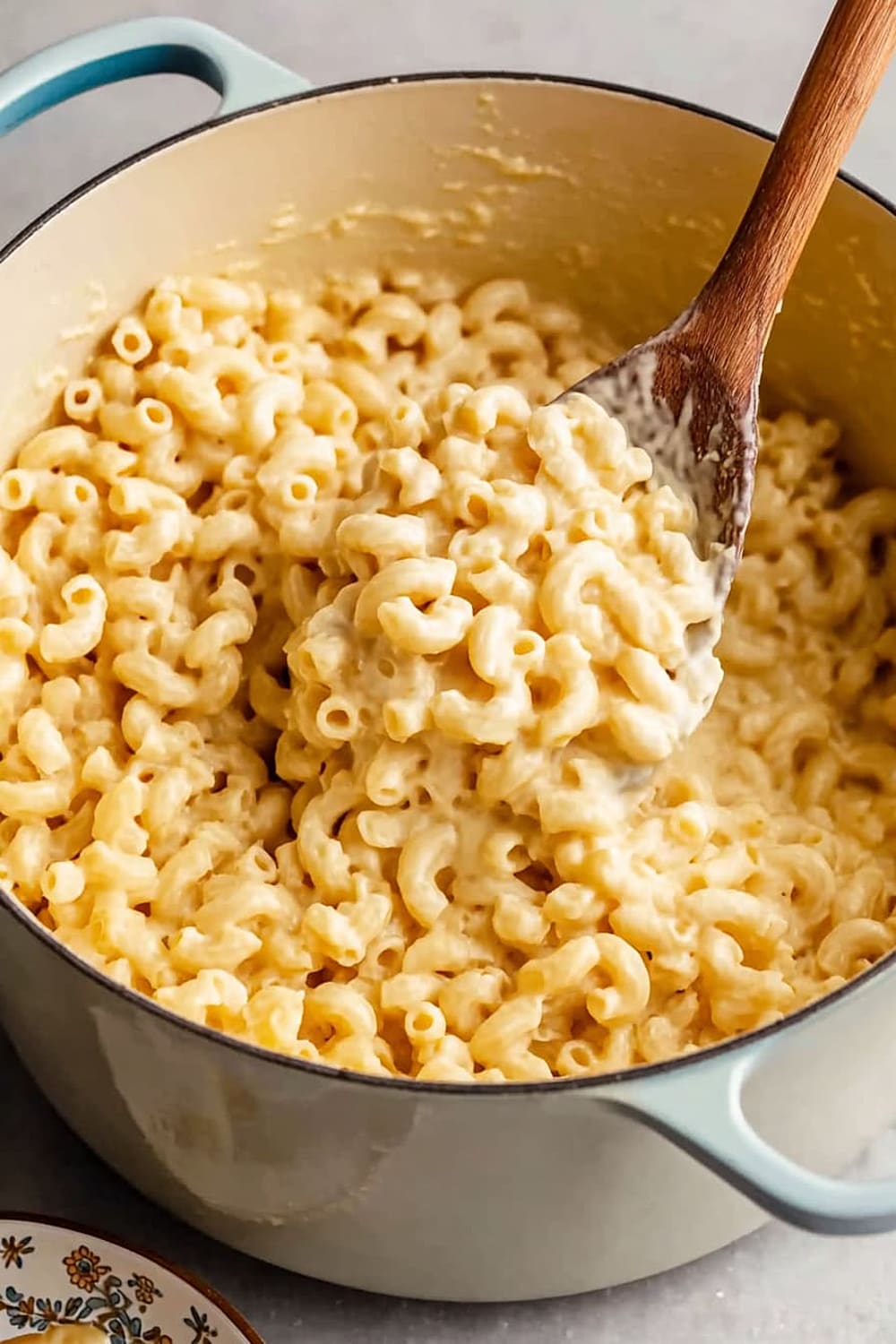
While other recipes have you making a roux and juggling multiple pans, this genius method lets you literally stir cheese into perfectly cooked pasta and watch it transform into liquid gold.
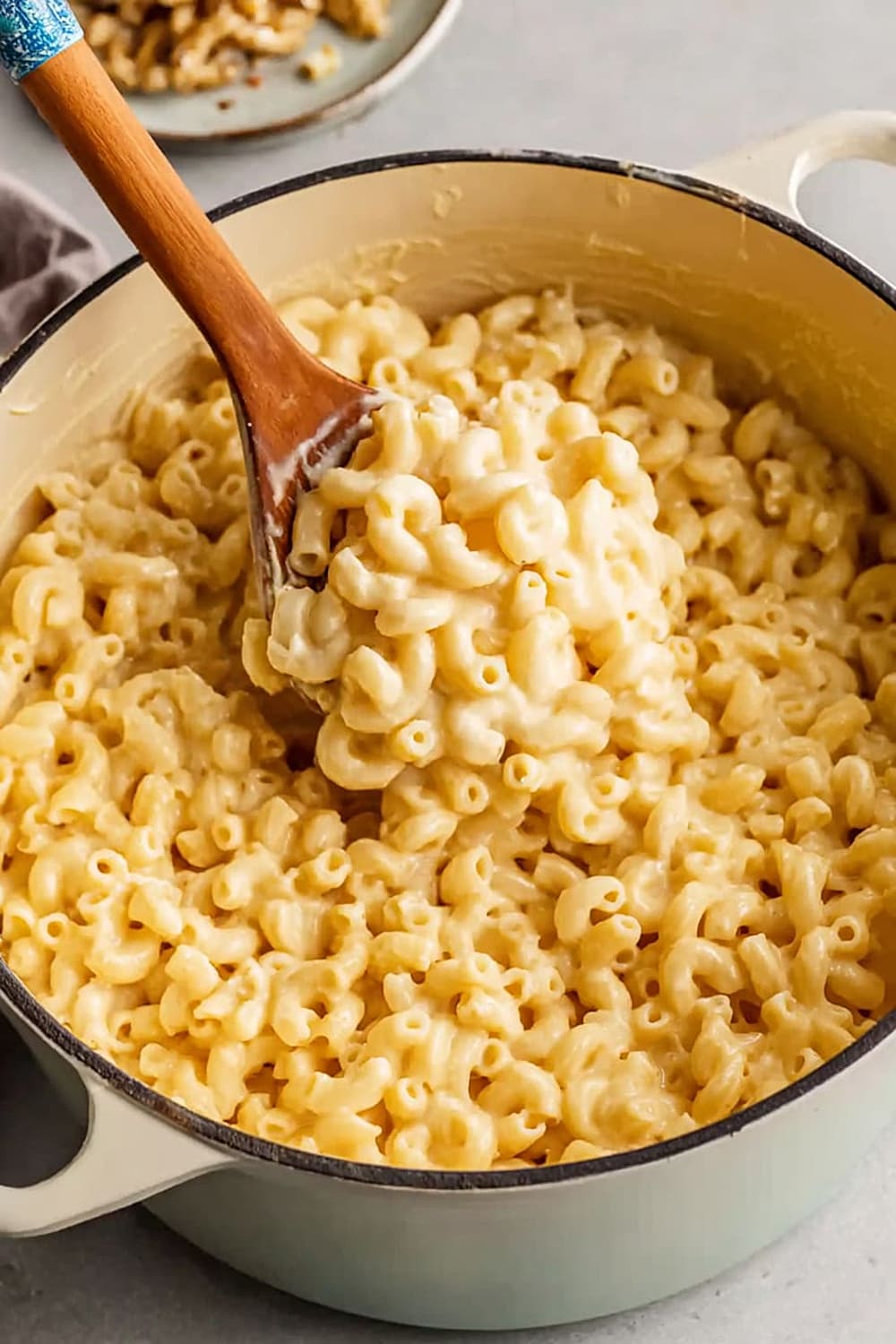
The result is so creamy and rich that people will assume you spent hours whisking a béchamel sauce, when really you just followed two simple steps and trusted the process.

Plus, with only five ingredients and 30 minutes from start to finish, this is the kind of recipe that makes you look like a kitchen wizard without actually requiring any wizardry.
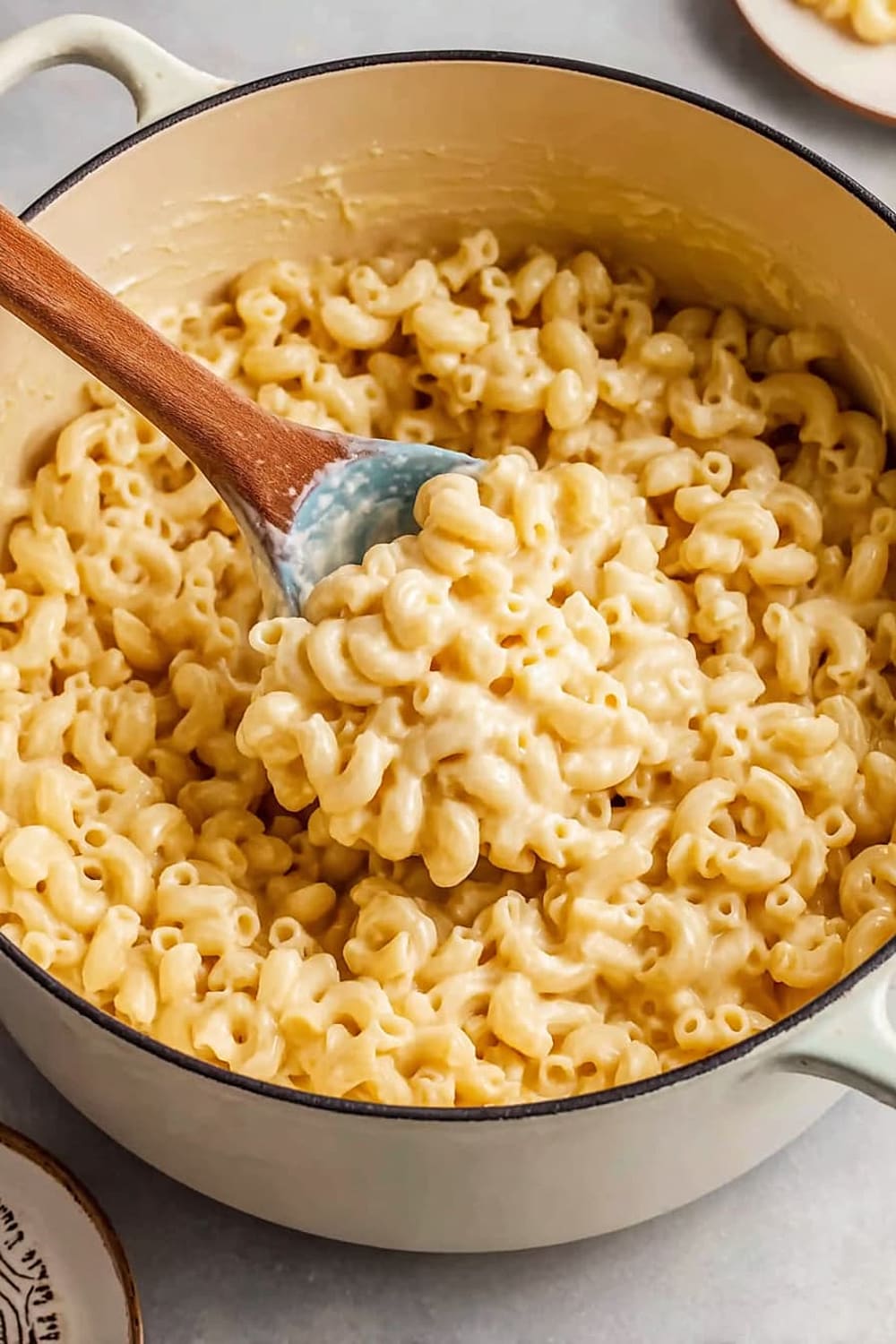
Ingredients
For the pasta base
- 2 cups whole milk (don’t skimp on the fat content – it’s essential for creaminess)
- 1¾ cups water (this ratio creates the perfect cooking liquid)
- 1 teaspoon kosher salt (for seasoning the pasta as it cooks)
- 1 pound dry elbow macaroni (classic shape that holds sauce beautifully)
For the cheese sauce
- 8 ounces sharp cheddar cheese, shredded (about 2 cups – freshly grated melts better than pre-shredded)
- 2 tablespoons unsalted butter (adds richness and helps the cheese melt smoothly)
- Freshly ground black pepper (optional, but highly recommended for a subtle kick)
Instructions
Prepare the cooking liquid
- 1 Place 2 cups whole milk, 1¾ cups water, and 1 teaspoon kosher salt in a large saucepan with a heavy bottom. The heavy bottom prevents scorching, which is crucial when cooking with milk. Use a saucepan that’s large enough to accommodate the pasta without overflowing – at least 4-quart capacity works best.
- 2 Bring the mixture to a rolling boil over medium-high heat, stirring occasionally to prevent the milk from forming a skin on top. You’ll know it’s ready when you see vigorous bubbling across the entire surface. This should take about 5-7 minutes depending on your stovetop.
Cook the pasta
- 3 Once boiling, reduce the heat to medium to maintain a steady simmer, then add 1 pound elbow macaroni all at once. The liquid level will drop temporarily – this is normal. Stir immediately to prevent the pasta from sticking to the bottom of the pan.
- 4 Simmer the pasta, stirring frequently every 2-3 minutes, until tender, about 10-12 minutes. The frequent stirring is crucial – it prevents sticking and helps release the pasta’s natural starches into the cooking liquid, which will thicken your sauce. The pasta is done when it’s tender but still has a slight bite, and the cooking liquid should look creamy and slightly thickened.
- 5 While the pasta cooks, shred 8 ounces sharp cheddar cheese using a box grater or food processor. Freshly shredded cheese melts much more smoothly than pre-packaged shredded cheese, which contains anti-caking agents that can make your sauce grainy. You should have about 2 cups of fluffy, freshly grated cheese.
Create the cheese sauce
- 6 Remove the saucepan from the heat completely – this is important because direct heat can cause the cheese to seize and become stringy. The residual heat from the pasta and cooking liquid will be perfect for melting the cheese gently.
- 7 Add the freshly shredded cheddar cheese and 2 tablespoons unsalted butter to the hot pasta. Stir continuously with a wooden spoon or silicone spatula until the cheese and butter are completely melted and the mixture becomes smooth and creamy, about 1-2 minutes. If the sauce seems too thick, you can stir in a splash of milk; if it’s too thin, let it sit for a minute to thicken naturally.
- 8 Taste and adjust seasoning with additional salt if needed, then top with freshly ground black pepper if desired. Serve immediately while hot – mac and cheese is best enjoyed right away when the cheese sauce is at its silkiest consistency.
Recommended Equipment and Kitchen Tools
Essential Tools (for best results)
- Large heavy-bottomed saucepan (4-quart minimum) – The heavy bottom distributes heat evenly and prevents the milk from scorching, which would ruin the entire dish
- Wooden spoon or silicone spatula – These won’t scratch your pan and are gentle enough for stirring the delicate cheese sauce without breaking it
- Box grater or food processor – Fresh cheese melts so much better than pre-shredded, and these tools make quick work of grating a full 8 ounces
- Liquid measuring cups – Accurate measurement of the milk-to-water ratio is crucial for the perfect cooking liquid consistency
Helpful Upgrades
- Kitchen scale – Weighing your pasta ensures consistent results every time, and 1 pound is exactly 454 grams if you prefer metric measurements
- Fine-mesh strainer – While not necessary for this recipe, it’s handy if you want to strain out any lumps from the cheese sauce
- Microplane grater – Creates the finest cheese shreds that melt almost instantly, resulting in an incredibly smooth sauce
Nice-to-Have Options
- Immersion blender – If your cheese sauce does get a bit lumpy despite your best efforts, a quick buzz with an immersion blender will smooth it right out
- Cast iron skillet – Some cooks like to transfer their finished mac and cheese to a cast iron skillet and broil the top for a crispy crust
- Storage containers – Glass containers with tight-fitting lids are perfect for storing leftovers, though this mac and cheese rarely lasts long enough to worry about storage
Recipe Variations and Dietary Modifications
Gluten-Free Adaptation
- Replace regular elbow macaroni with 1 pound gluten-free pasta (corn or rice-based work best)
- Increase cooking time by 2-3 minutes as gluten-free pasta typically takes longer to reach tenderness
- Stir more frequently to prevent sticking, as gluten-free pasta can be more delicate
- The cooking liquid may need an extra ¼ cup water since gluten-free pasta can absorb more liquid
Dairy-Free Modifications
- Substitute 2 cups unsweetened oat milk or cashew milk for the whole milk (these create the creamiest texture)
- Use 8 ounces dairy-free sharp cheddar shreds and 2 tablespoons vegan butter
- Add 1 tablespoon nutritional yeast for extra cheesy flavor depth
- Consider adding 1 teaspoon Dijon mustard to enhance the tangy cheese flavor
Flavor Variations
- Smoky bacon version: Stir in 4 strips cooked, crumbled bacon with the cheese
- Spicy jalapeño: Add 2-3 minced jalapeños to the cooking liquid
- Herb-crusted: Top with ½ cup panko breadcrumbs mixed with 2 tablespoons melted butter and broil for 2-3 minutes
- Three-cheese blend: Use 4 ounces sharp cheddar, 2 ounces gruyere, and 2 ounces cream cheese for ultimate richness
- Truffle mac: Stir in 1 teaspoon truffle oil just before serving for an elegant upgrade
Protein Additions
- Lobster mac: Fold in 1 cup cooked lobster meat for a restaurant-style dish
- Buffalo chicken: Add 1 cup shredded rotisserie chicken and 2 tablespoons buffalo sauce
- Ham and pea: Stir in 1 cup diced ham and ½ cup frozen peas during the last minute of cooking
Nutritional Information and Health Benefits
Key Nutritional Highlights
This comfort food classic provides approximately 385 calories per serving when divided into 8 portions. Each serving delivers about 15 grams of protein from the combination of pasta, milk, and cheese, making it more substantial than many people realize. The dish provides 45 grams of carbohydrates primarily from the pasta, along with 16 grams of fat from the cheese, butter, and whole milk. You’ll also get about 2 grams of fiber per serving from the enriched pasta.
Health Benefits of Main Ingredients
The whole milk in this recipe provides high-quality complete proteins containing all essential amino acids, plus significant amounts of calcium, vitamin D, and vitamin B12. Sharp cheddar cheese is an excellent source of calcium for bone health, providing about 200mg per serving, plus phosphorus and vitamin K2. The pasta is typically enriched with B vitamins including folate, niacin, and iron, which support energy metabolism and red blood cell formation. Butter contributes fat-soluble vitamins A, D, E, and K, which aid in nutrient absorption from other ingredients.
Dietary Considerations
This recipe contains gluten from wheat pasta and lactose from dairy products, so it’s not suitable for those with celiac disease or lactose intolerance without modifications. The dish is vegetarian-friendly and provides a good balance of macronutrients. For portion control, consider serving with a large green salad or steamed vegetables to increase fiber and nutrients while moderating the calorie-dense mac and cheese portion.
Smart Swaps and Ingredient Substitutions
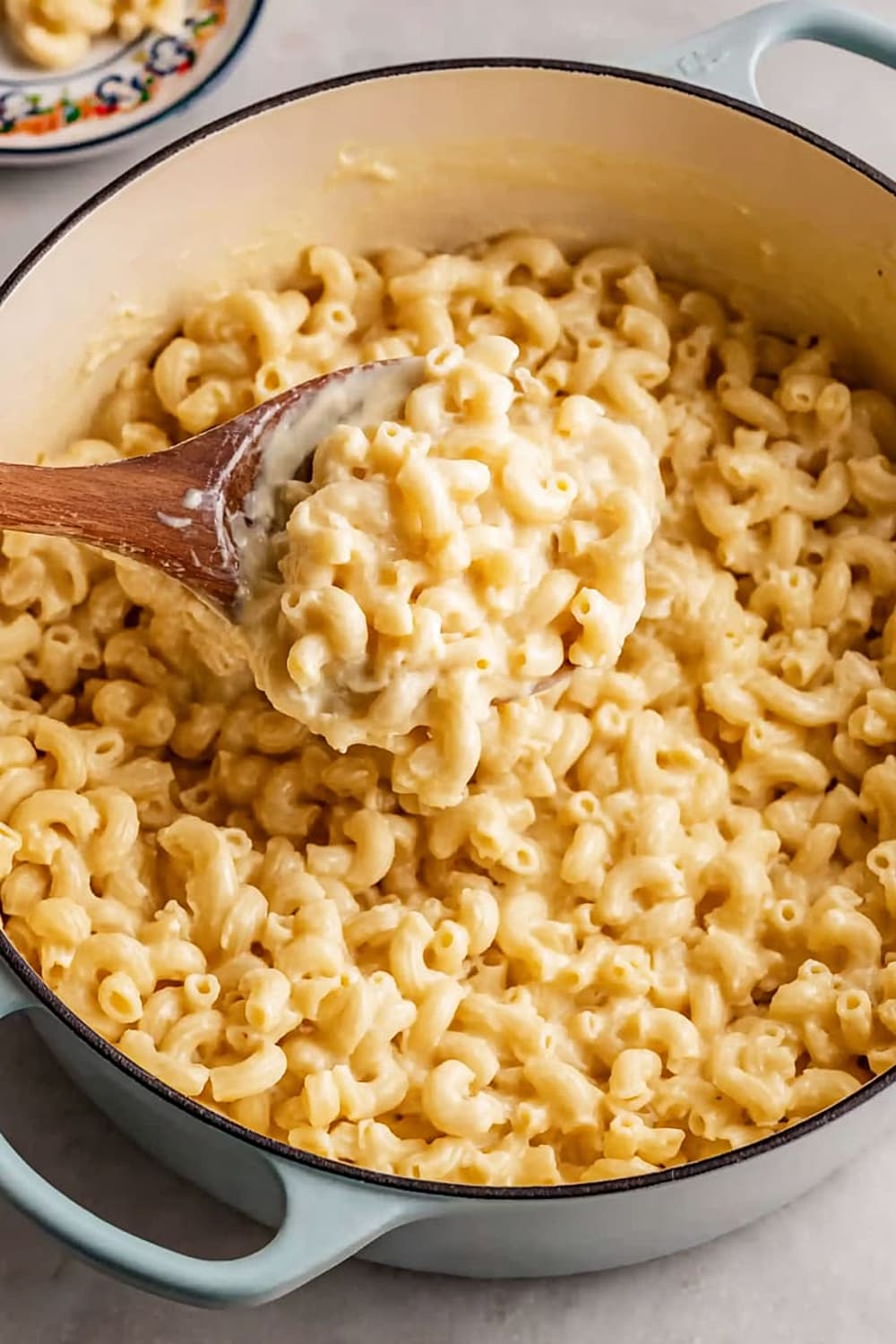
Common Substitutions:
- Whole milk → 2% milk + 2 tablespoons heavy cream for similar richness, or evaporated milk diluted with equal parts water for extra creaminess
- Sharp cheddar cheese → Gruyere, aged white cheddar, or smoked gouda for different flavor profiles (use same amount)
- Elbow macaroni → Shells, cavatappi, or gemelli – any short pasta with curves that hold sauce well
- Unsalted butter → Salted butter (reduce added salt by half) or cream cheese for extra tanginess
Budget-Friendly Swaps:
- Sharp cheddar → Medium cheddar + 1 teaspoon Dijon mustard to add sharpness without the premium price
- Whole milk → 2% milk + 2 tablespoons flour whisked in for thickness (add flour to cold milk first)
- Fresh-grated cheese → Pre-shredded cheese (works fine, just toss with a bit of flour to help it melt smoothly)
Pantry Emergency Substitutions:
- No milk? → 1 cup heavy cream + 1 cup water or 1 can evaporated milk + ¾ cup water
- No cheddar? → Any melting cheese like Monterey Jack, Colby, or even mozzarella (though flavor will be milder)
- No elbow pasta? → Any pasta shape you have – even spaghetti broken into pieces works in a pinch
Pro Tips for Substitutions:
- When using pre-shredded cheese, toss it with 1 teaspoon cornstarch to help it melt smoothly
- If substituting lower-fat milk, add 1 tablespoon flour to the cold milk before heating to prevent curdling
- Store opened blocks of cheese wrapped in parchment paper, then plastic wrap, to prevent drying out
Make It Diabetes-Friendly
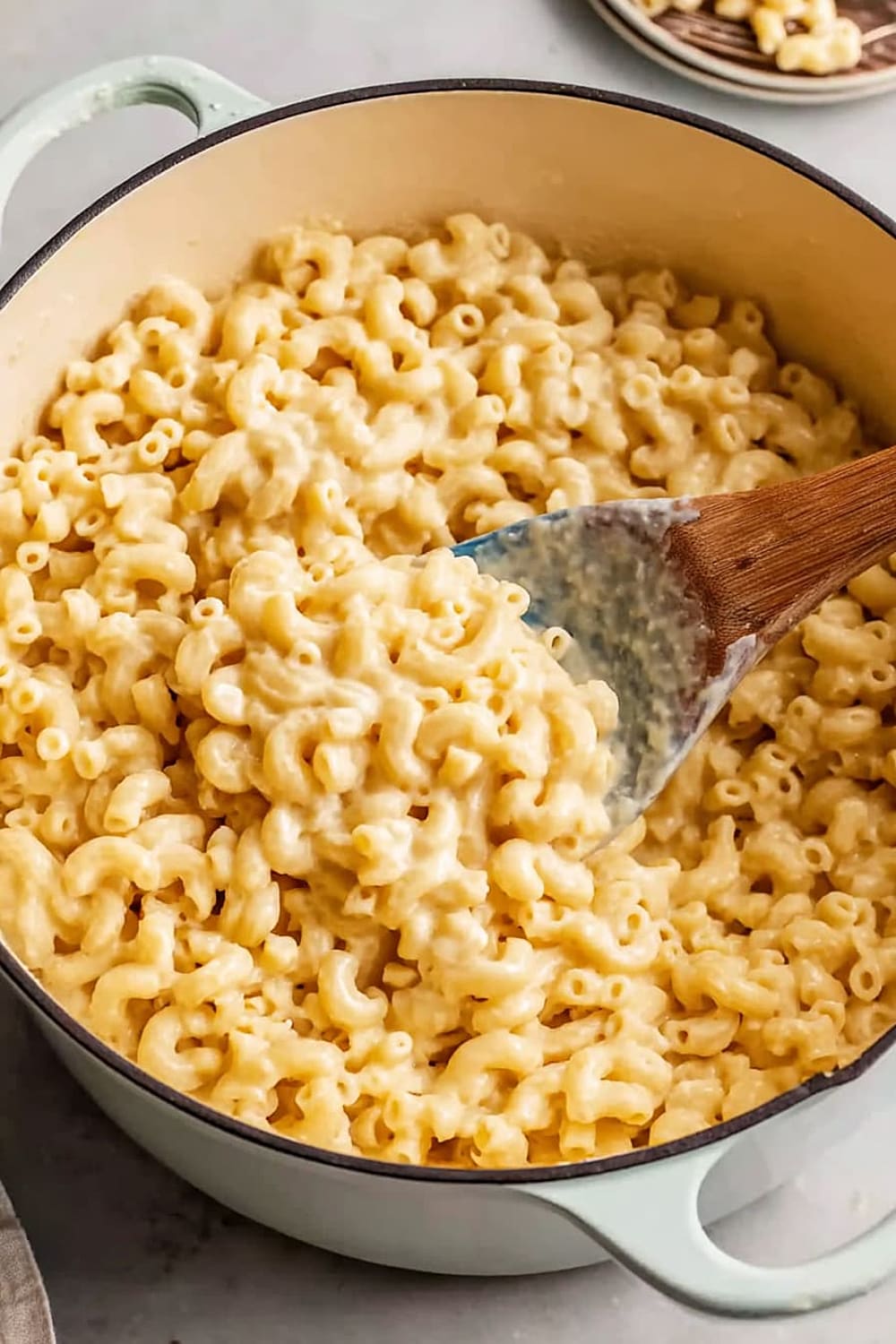
Carb Reduction Strategies:
- Replace half the pasta with 2 cups cauliflower florets or zucchini noodles to cut carbs by approximately 20 grams per serving
- Use shirataki noodles mixed with 8 ounces regular pasta instead of a full pound for a 15-gram carb reduction per serving
- Try chickpea or lentil pasta which provides more protein and fiber, helping to slow blood sugar response
Portion & Fiber Modifications:
- Serve ¾ cup portions instead of larger servings and pair with 2 cups steamed broccoli or mixed green salad
- Add 1 cup frozen cauliflower florets during the last 3 minutes of pasta cooking to increase volume without significantly increasing carbs
- Stir in 2 tablespoons ground flaxseed after adding cheese for 4 grams extra fiber per serving
Blood Sugar Management Tips:
- Pair with 4 ounces lean protein like grilled chicken or baked salmon to slow carbohydrate absorption
- Add 1 tablespoon olive oil and 2 cups sautéed spinach to increase healthy fats and nutrients
- Consider eating this as a side dish rather than main course, with ½ cup servings alongside protein and vegetables
Estimated Carb Content: Modified version contains approximately 28-32 grams carbs per serving compared to 45 grams in the original recipe
Perfect Pairing Suggestions
Beverage Pairings
A crisp Sauvignon Blanc or Pinot Grigio cuts through the richness beautifully, while Chardonnay complements the creamy texture without competing. For beer lovers, a light lager or wheat beer provides refreshing contrast to the cheese. Sparkling water with lemon or unsweetened iced tea offer palate-cleansing non-alcoholic options. During colder months, hot apple cider creates a cozy autumn pairing that feels like the ultimate comfort meal.
Side Dish Recommendations
Roasted Brussels sprouts with bacon provide a crispy, slightly bitter contrast that balances the creamy pasta perfectly. A simple arugula salad with lemon vinaigrette adds peppery freshness and helps cut through the richness. Honey-glazed carrots or roasted broccoli contribute color, nutrients, and textural variety. For heartier appetites, garlic bread or herb-crusted dinner rolls turn this into a truly indulgent feast.
Complete Meal Ideas
Start with a light soup like tomato basil or butternut squash, serve the mac and cheese as the main course with grilled chicken or pan-seared pork chops, and finish with a fresh fruit salad or lemon sorbet. For casual entertaining, pair with pulled pork sliders and coleslaw for a comfort food spread that pleases crowds. Holiday meals benefit from serving this alongside glazed ham or roasted turkey as an elevated side dish.
Occasion Suggestions
Perfect for Sunday family dinners, potluck gatherings, or weeknight comfort meals when you need something satisfying fast. Excellent for kids’ birthday parties or casual entertaining since it appeals to all ages. During fall and winter months, this pairs beautifully with soup suppers or game day spreads.
Pro Tips and Troubleshooting
Professional Techniques
Always remove the pan from heat before adding cheese – residual heat melts it perfectly without risking a grainy, seized sauce. Grate cheese fresh using the large holes of a box grater for the smoothest melting. Stir constantly but gently when adding cheese to prevent breaking the emulsion. If you want an extra-silky texture, strain the finished sauce through a fine-mesh sieve to remove any small lumps.
Common Mistake Prevention
Never let the cheese sauce boil after adding the cheese, as this causes separation and graininess. Don’t use pre-shredded cheese if you can avoid it – the anti-caking agents can make your sauce less smooth. Avoid low-fat milk as it lacks the fat content needed for proper creaminess and is more likely to curdle. Don’t overcook the pasta during the initial cooking phase, as it continues to soften slightly as it sits in the hot cheese sauce.
Storage and Reheating
Store leftovers in the refrigerator for up to 3 days in airtight containers. To reheat, add 2-3 tablespoons milk per cup of mac and cheese and warm gently in the microwave in 30-second intervals, stirring between each interval. For stovetop reheating, use low heat and add milk gradually until you reach the desired consistency. Freezing isn’t recommended as dairy-based sauces tend to separate when thawed.
Make-Ahead Strategies
This recipe is best served immediately, but you can prep ingredients in advance by pre-shredding cheese and measuring out milk and water. For entertaining, double the recipe and keep warm in a slow cooker on the warm setting for up to 2 hours, stirring occasionally and adding milk if needed to maintain consistency.
This creamy, dreamy mac and cheese proves that the best comfort food doesn’t require complicated techniques or fancy ingredients – just quality ingredients treated with care and a little bit of kitchen magic that happens when you trust the process.